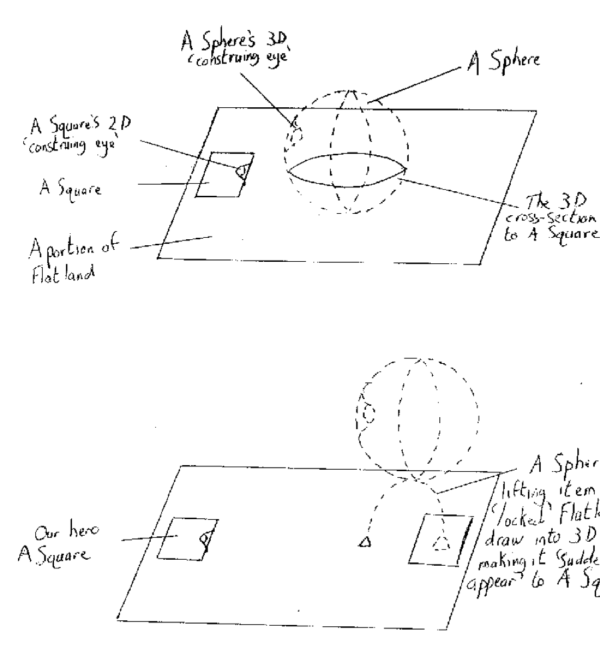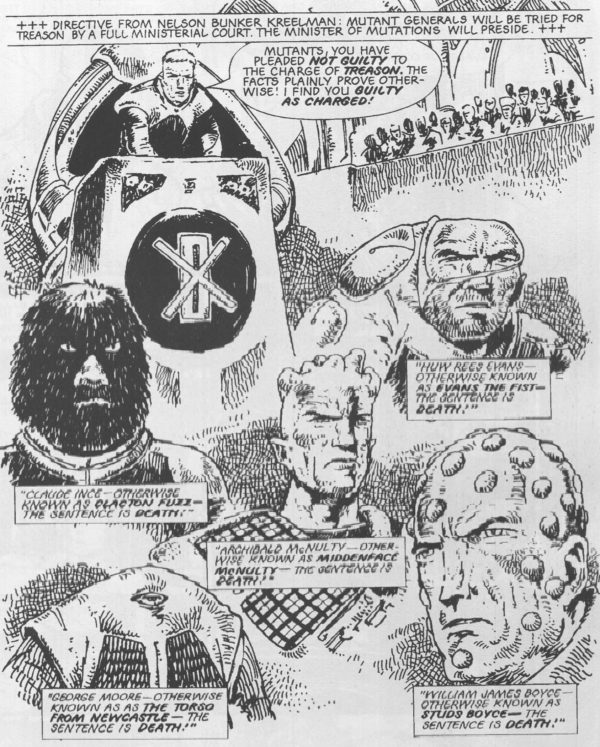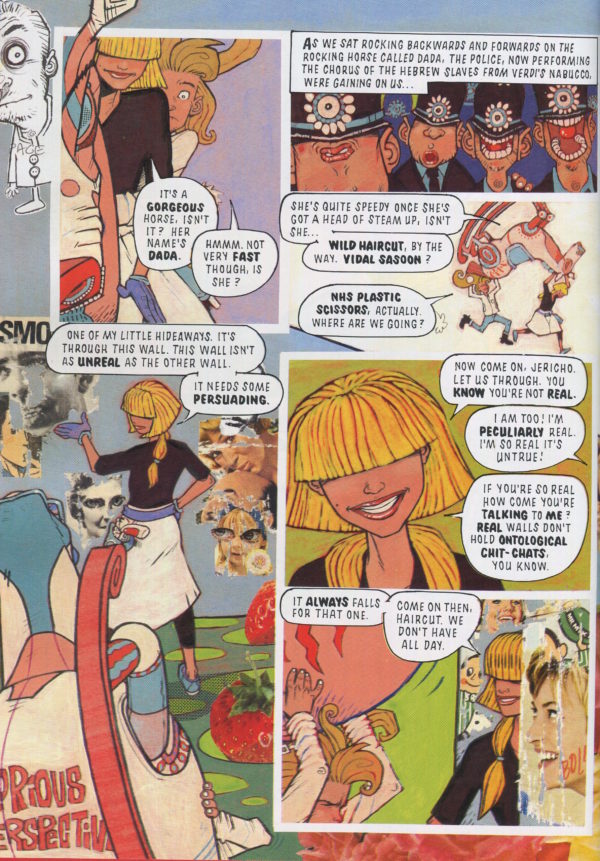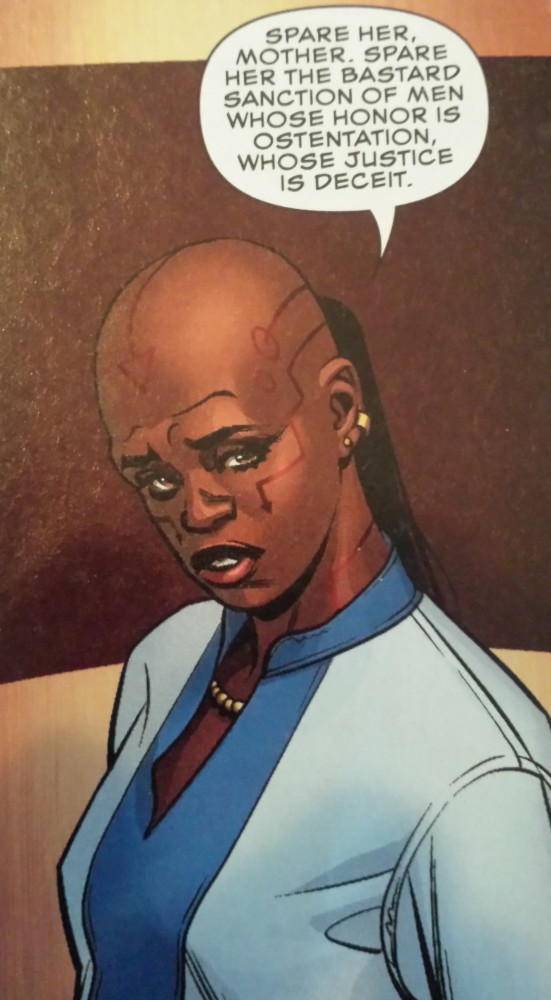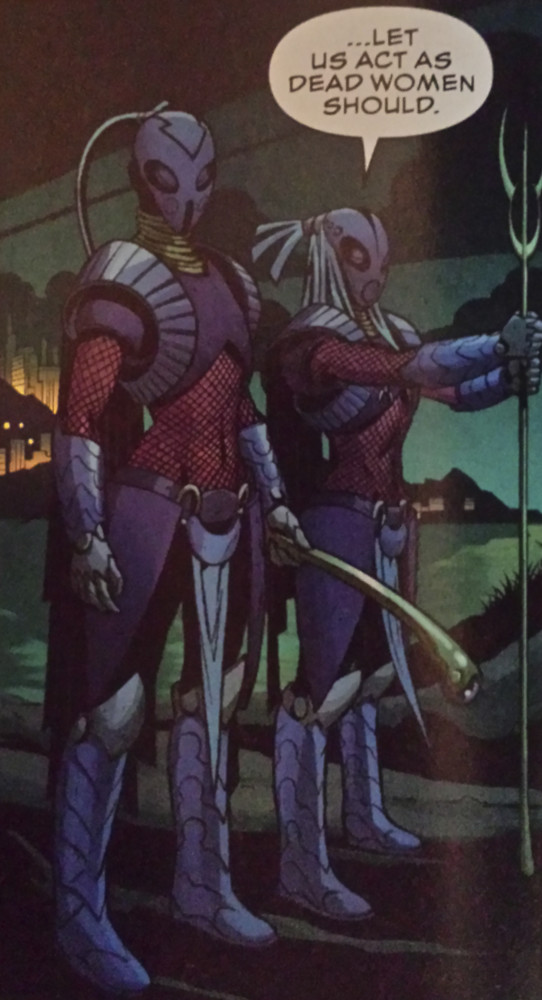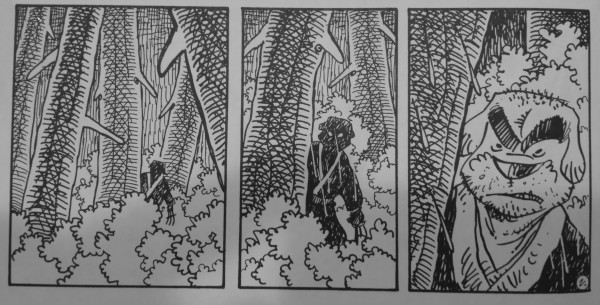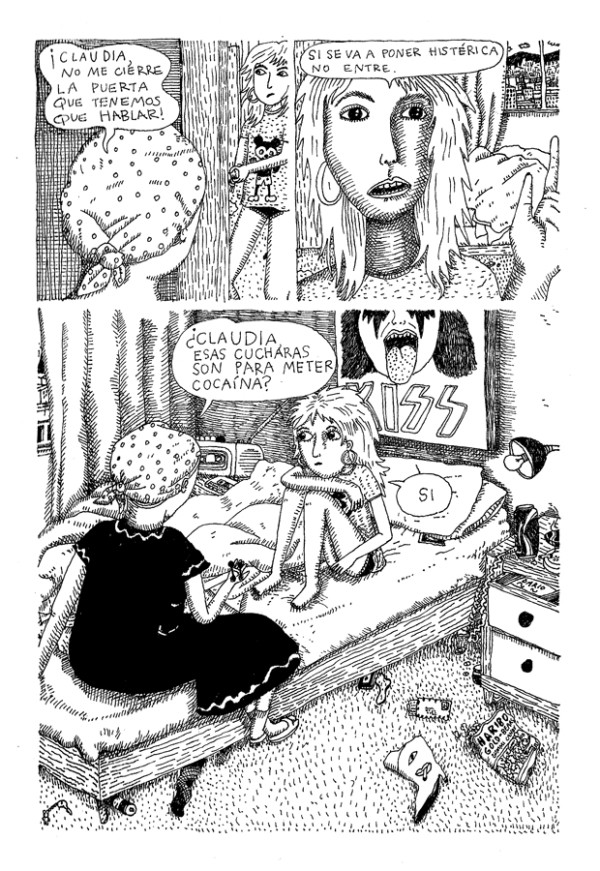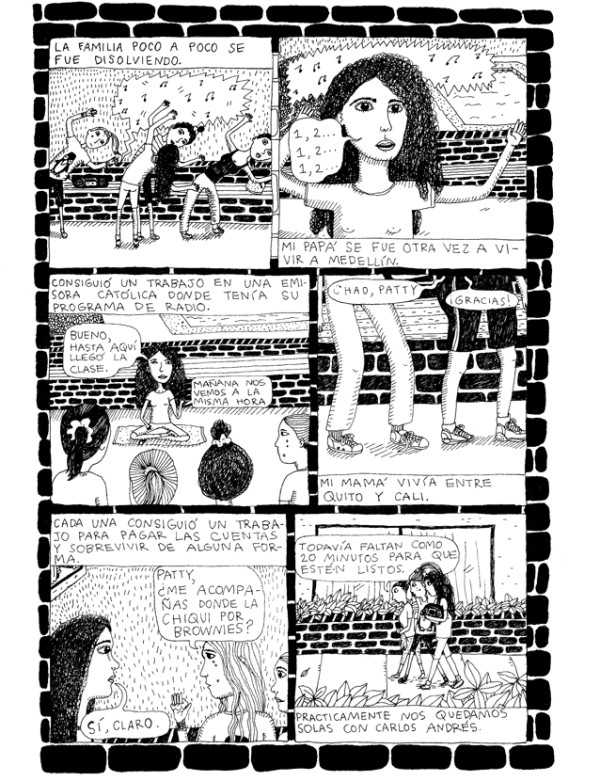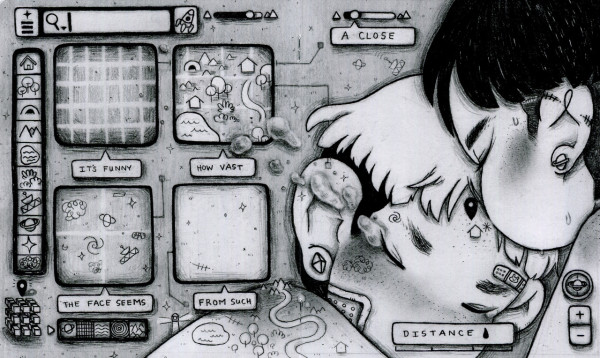What We’re Reading: Jerusalem, Part 1

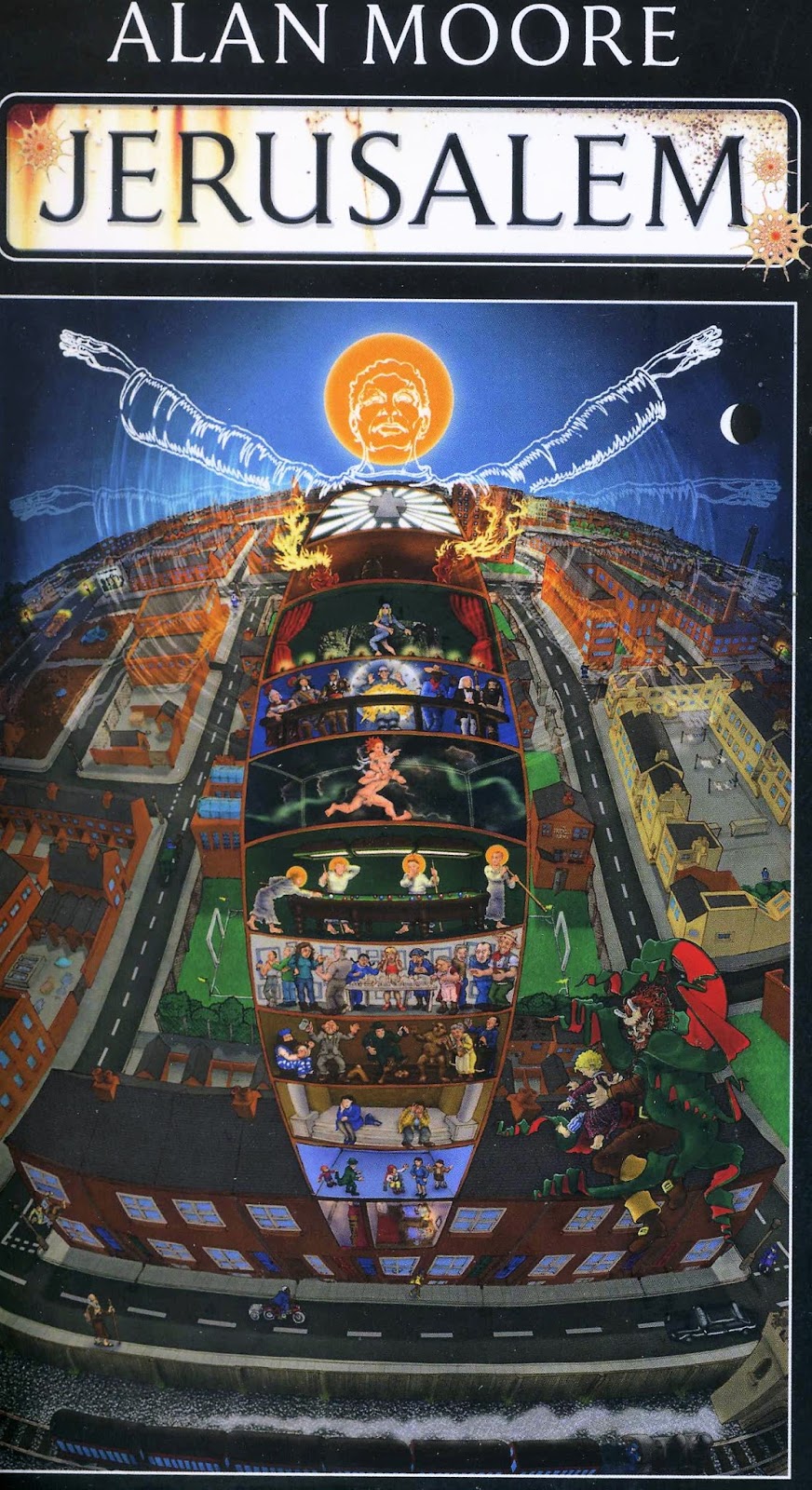 One of Hazel & Wren’s New Year resolutions is to find new ways to engage with and review books. You’ve already seen our review roundups, and here’s another grand experiment: a yearlong, co-reviewed readalong of Alan Moore’s newest novel, Jerusalem.
One of Hazel & Wren’s New Year resolutions is to find new ways to engage with and review books. You’ve already seen our review roundups, and here’s another grand experiment: a yearlong, co-reviewed readalong of Alan Moore’s newest novel, Jerusalem.
Jerusalem is 1,200 pages of magical realism, historical fiction, and experimental prose about Northampton, England. Each month, we’ll read approximately 100 pages and post a short roundtable discussion. And the coolest part? You can read along and join the discussion! Let’s pick this beast of a book apart.
This month, Josh and Aaron will be discussing the first 97 pages. With 1,100 pages to go, there’s still time for you to grab a copy and join in.
Aaron: A majority of the first 100 pages is about members of the Vernall family across generations. One restores church frescoes in the late 19th century. Others paint and dream in the modern day. All of them suffer from mental illness.
First of all, it feels like this is going to be a book about perspective. Alma’s opening scene is about architecture and angles, and she thinks about the family madness in metaphor, pondering those ancestors who’ve gone round the turn, the bend, the twist, effectively disappearing from view. Mental illness makes someone invisible, no longer able to be perceived in traditional ways.
Josh: It’s a curious way to start a book, right? It at once lets us know the scope of this thing he’s given us, the truly omniscient attempts at narration. It’s as though Moore wants to be clear with us right from the get-go: this book will shy away from no consideration of place, person, or perspective, so buckle up. It reminds me of Mervyn Peake’s Gormenghast books wherein Peake is happy—thrilled, even—to spend huge amounts of time widening his perspectival scope, not for considerations of plot or even character but because of his fidelity to truth, as though you can only really understand a person in a place by totally and completely seeing/understanding the place itself. This seems to be a touch of what Moore is after here right from the start.
A: The Gormenghast reference is a perfect one! I loved how inseparable Peake’s prose was—labyrinthine, precarious, and unexpected—from the shape of Gormenghast Castle. It forced the reader to experience from the perspective of the characters.
And speaking of characters’ perspectives, when Ginger Vernall is raised up to paint a chapel ceiling, he has the pleasure of looking down on two monks coming around a corner at the same time. Ginger knows beforehand that they’re going to collide before it happens; in the right conditions, perspective can be the same thing as precognition.
Are the strange visions the characters suffer also a consequence of a changed perspective? And does that perspective shift come from their mental illness, or does the madness come from a changed perspective? Or it something more magical, more science-fictional? Are there actual angels and demons who are viewing us from a higher dimension and thus appear to teleport or extrude themselves into our world in weird ways a la Flatland?
(diagram from Flatland)
J: I’ve been wondering some of this same stuff, too! The supernatural, such as it is, walks a really thin line here, I think. The elision of madness and magic is well-trod territory and can verge on offensive when romanticized, but Moore seems really interested in showing both sides of that line: the beauty and wonder of seeing angels building in the middle of the night juxtaposed with lives and bodies and minds broken, seemingly irreparably.
I’m curious to read more and see how the book continues to make use of the supernatural forces here that seem to be flittering around the edges of things, coming forward at moments and hanging back at others.
A: Taking a turn from the supernatural to the realistic: Jerusalem also feels like a book about the working class. Moore’s Northampton is poor and dirty, full of damaged infrastructure , subsidized housing, and CCTV cameras. Food is scarce in Ginger’s time, and pubs are empty in the present day. No one has money to spend, but they work all the time. With so many novels about writers, professors, and other white-collar workers, it’s nice to read something about the blue collars.
J: Yes! I was thinking this same thing. I’m fascinated by the way Moore navigates space in this book; it feels very Dickensian to me. Class (and specifically the working class) seems to somehow thrive in these tight, sometimes-grubby, carefully described, much loved spaces, especially since most of the spaces in this book become defined by their workability. Even the sense of beauty Moore finds in this place is often wrapped up in industrialization of some sort.
“A fat pearl cylinder of failing daylight coloured by the worsening storm outside dropped from the windows of the Whispering Gallery to the cathedral’s flooring down below, dust lifted by the bustling industry caught up as suspension in its filmy shaft” (50).
A: And being stuck in the working class, being stuck in a dead-end job or with a drug addiction like Marla has in the third section of the book—that’s its own form of perspective limitation. Marla herself hints at it when she’s thinking about her drug addiction:
“Not feeling like a fucking angel on fire, forget that, that’s not going to happen for you anymore, no, no, just feeling like a fucking person like you was again for just ten fucking minutes, that’s your fucking big ambition these days. Heaven, where you went the first time, that’s all shut. The ordinary world you used to be in, that’s shut too, most of the time, and you’re stuck somewhere else, somewhere that’s under all of that, like being under fucking ground.”
Marla, as a person of color, a sex worker, and a drug addict, has had her perspective squashed like a Flatlander’s. She can’t see up or down, only looking forward.
J: Your ideas about perspective limitation are really great, and Marla is a great example of this. She has such a complicated relationship with memory—she seems to be a character at once struggling to keep one foot out of the past and the other in her present. I keep thinking of her interaction with that fellow on the street—the one with the big nose who Marla tries to take a run at. I wonder about how that interaction gets narrated, with Marla continuously running into her inability to figure this guy out, getting caught up on his strange speech, unable somehow to extend her perspective deeper into who he might be or what might be going on with him (beyond just calling him “really mental”).
I’m wondering about the place of the reader in this book. At times during these first 100 or so pages, I felt encouraged—even demanded—to pay really close attention to detail in the text. Moore pushes off plot in favor of this encyclopedic lens—every detail, significance thrown out the window, recorded and captured. And so I invest myself where he asks me to, but there are times where I feel a little punished for that investment. I end up overloaded, juggling information (like reading one of the great Russian novels and trying to keep characters straight in your head) that I have no idea how to prioritize. Did you experience anything like that?
A: Not consciously, but now that you brought it up, jeez! So many thoughts.
When I started the book, when I was walking through that first dream world, I definitely considered keeping a list of characters and relationships and terms I didn’t understand—with everything being given that same encyclopedic (great term for it, by the way) weight, I was left without the traditional narrative signals of, “Hey, this thing is important!”
Feeling that way, though, always pulls me in two directions. The first is, “Everything is important and I must keep track of it all.” That was the note-taking instinct…which I ignored, because I’m a terrible student. Instead, I ended up where I always end up—with everything being given the same narrative weight, I felt like it was up to me to choose what was important to me. With everyone in the book walking everywhere (which is probably something I’ll come back to), I get the pleasure of walking along with them, focusing on things that catch my eye and letting my eyes glaze over if they need to. But maybe I’m just a bad reader. Regardless, it reminded me (probably on purpose) of Mrs Dalloway and Ulysses and all the other British walking-around novels.
Next month, we’re reading to page 207. Please join us!
Supplemental reading:
Flatland: A Romance of Many Dimensions (1884) by Edwin Abbott Abbott
Titus Groan (1946), Gormenghast (1950), and Titus Alone (1959) by Mervyn Peake
Mrs Dalloway (1925) by Virginia Woolf
It can be a struggle to get foreign comics in America. While the manga boom proved that there was an audience for translated work, the publishers rarely looked past Japan—where manga was easy enough to format, what with it being the perfect size for mass consumption, other countries’ comics proved more of a challenge.
So comic stores are littered with failed imports. Full-sized French hardcovers failed; maybe it was the high price attached to lower-than-usual page counts. But on the other hand, chopping them down to something approaching manga size (as was done with Italian Hugo Pratt’s Corto Maltese) brings cries of bowdlerization.
Recently, I’ve gotten my hands on four collections of strips from Britain’s 2000 AD. 2000 AD is a sci-fi anthology comic that’s been released once a week since 1977, each issue containing a number of short chapters from ongoing stories. In America, the multi-artist anthology has been, for the most part, slowly dying since the ‘70s. Exceptions emerge, but as a viable format, especially on the level of 2000 AD, anthologies just don’t work in the US.
What follows, then, are looks at four different strips from 2000 AD collected in four different formats.
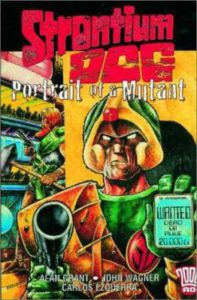 Strontium Dog: Portrait of a Mutant by Alan Grant, John Wagner & Carlos Ezquerra (2000 AD/Titan Books)
Strontium Dog: Portrait of a Mutant by Alan Grant, John Wagner & Carlos Ezquerra (2000 AD/Titan Books)
This is the earliest collection of the four—the stories were first printed in the early ‘80s, and the collected edition came out in 2002. (Funny story: when 2000 AD began, no one expected it to last as long as it did. Thus the “futuristic” name.)
This collection is also one of the largest, measuring 8 ¾” by 11 ¾”. It’s a softcover, and the covers sure don’t hold up well. It’s the kind of cover that curls and splits at the corners. Inside, the book collects two discrete storylines, the titular “Portrait of a Mutant” followed by “The Shicklgruber Grab.” This is not the original print order of the stories but is instead chronological order of the fiction.
Strontium Dog is the story of Johnny Alpha, a mutant bounty hunter with X-ray eyes. In his irradiated future, he takes jobs that humans find too dirty. “Portrait of a Mutant” details his origin in the wars for mutant rights. In “The Shicklgruber Grab,” Johnny travels back to Nazi Germany to kidnap Hitler and bring him to the future to stand trial.
The stories are fast-paced, full of dry humor and quick plot work. With just five pages per chapter, no one is allowed to stand still and emote unless it’s atop a flaming spaceship crashing to its doom. It reminds me of Fury Road: any sort of bloat has been edited out. The large size is perfect for Ezquerra’s scratchy inks and densely populated panels. His mutant designs are varied and unique, and he never repeats himself.
But where to after this? There’s no volume numbering anywhere in Portrait of a Mutant and no indication if another book is forthcoming. Is this the end of Johnny Alpha?!
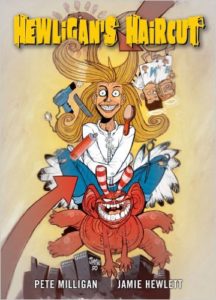 Hewligan’s Haircut by Peter Milligan & Jamie Hewlett (2000 AD)
Hewligan’s Haircut by Peter Milligan & Jamie Hewlett (2000 AD)
This collection only slightly edges Strontium Dog out in size, but only because it’s a hardcover. Collected in 2003, the story was originally printed in eight installments in 1990, making it the shortest collection.
The story sounds complicated: madman Hewligan is released from an asylum after giving himself a strange haircut, and he tours art-inspired parallel dimensions with his manic pixie dream girl, Scarlet. In the end, because this is 1990, Hewligan accepts and overcomes his madness with the power of love and the help of his quirky girlfriend. It’s vaguely insulting in the same way as the spate of MPDG films of the aughts (Elizabethtown, 500 Days of Summer)—madness is cute, and a man can only succeed in life with the help of a woman who does the emotional work for him.
The story has an odd pace, with Hewligan and Scarlet wandering through Dada, Pop Art, and beyond. Despite the same structure as Strontium Dog (multiple five-page chapters), it has none of the stakes. Someone is supposedly chasing the protagonists, but with a universe of cartoon escape routes, the tension never gets above a low simmer. But there is some good here! Hewlett, known for his design work with the Gorillaz, constructs a multimedia collage of dueling monochrome and saturation.
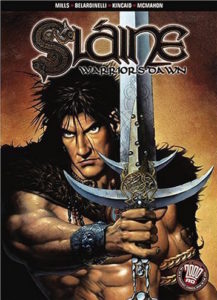 Sláine: Warrior’s Dawn by Pat Mills, Angeie Kincaid, Massimo Belardinelli & Mike McMahon (2000 AD/DC Comics)
Sláine: Warrior’s Dawn by Pat Mills, Angeie Kincaid, Massimo Belardinelli & Mike McMahon (2000 AD/DC Comics)
These stories originally appeared in 1983 and ’84 and were collected in 2005 as a part of a short-lived partnership with DC Comics (of Batman and Superman fame). Written by 2000 AD founder Pat Mills, Warrior’s Dawn follows Celtic barbarian Sláine (and sidekick Ukko) as they hew their way through a fantastical Bronze Age England.
Sláine’s world is strange and cruel. He fights time-displaced dinosaurs, rescues evil druidesses, and rides flying boats. And whenever things get rough, his body warps into a roiling, swelling thing that feels no pain. While some of the art is mediocre, looking posed and confusing, McMahon’s scratchy style is a perfect fit, and it thankfully fills most of the pages. Each of his panels feels like a dirt-smeared etching some archaeologist was lucky enough to dig up.
This collection, while not as large as the previous two, does at least indicate that it’s the first in many volumes, and it reprints the original stories in order. If only the partnership had lasted…
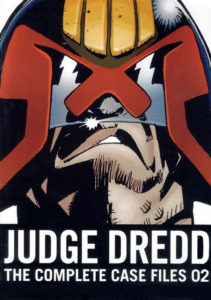 Judge Dredd: The Complete Case Files 02 by John Wagner, Pat Mills, Brian Bolland, et al
Judge Dredd: The Complete Case Files 02 by John Wagner, Pat Mills, Brian Bolland, et al
This is the beefiest collection of them all. While the pages aren’t numbered (why not?!), this book is at least three times as long as the others. With comics that have been around as long as 2000 AD, this approach makes the most sense to me: hundreds of pages in chronological order in clearly numbered volumes.
Except four chapters are missing due to lawsuit. The missing chapters took aim at some lovable fast food mascots, and the original publisher settled out of court.
Anyway, the stories are similar to Strontium Dog: fast-paced postapocalyptic romps that only pause to tell dark jokes and survey the carnage. Dredd and his fellow judges are fascists working for a literal police state, but the forces they fight are worse, so readers can root for them even if they can’t excuse them. The art is much more consistent than in Sláine; Mike McMahon makes another appearance here, adopting a much slicker style for the brutalist-futuristic look of Dredd’s Mega City.
There we have it, readers. Apologies if this was more of a review of formats than a review of content. Do the same concerns every apply to text-only books? Have you ever found the format of a book to affect your reading of it?
Recently, there’s been a lot written about how people currently buy comics and how they should buy them. There are definitely ways to improve the industry, but however things shake out in the future, I hope I’ll still be able to buy monthly comic books.
When I worked in a comic store, I was spending unimaginable amounts of money on the 20- to 64-page comics that are almost inevitably (at least these days) collected into books with spines and distributed to bookstores. It was also a time of frantically following comic news sites, reading interviews, tracking rumors of upcoming books, and participating in the loosely connected nation-states of the comics community.
It was a lot of time and money spent on things I’d eventually get rid of (moving sucks), but even now, years after, I’m still drawn to the occasional serialized comic. Done well, a serialized comic can feed the same hunger that shows like Game of Thrones do—an intense desire to know what happens next coupled with a group of like-minded readers who spin predictions and conspiracy theories about future plotlines. That said, here are a few comics I still anticipate every month.
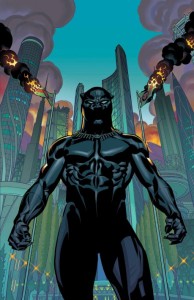 Black Panther by Ta-Nehisi Coates, Brian Stelfreeze, Chris Sprouse, Karl Story, and Laura Martin (Marvel, 2016)
Black Panther by Ta-Nehisi Coates, Brian Stelfreeze, Chris Sprouse, Karl Story, and Laura Martin (Marvel, 2016)
I’m always intrigued when prose writers move to comics. Sometimes, I like their comics more than I like their prose. (I’m looking at you, Jonathan Lethem.) Sometimes, it’s so bad that future writers ignore or actively overturn the stories. (Sorry, Orscon Scott Card.) And sometimes, the transition is seamless.
Black Panther is one of those times. The book leaps from one genre to another: tense political thriller, magical realist family saga, and two-fisted superhero action are all woven together to create a slow-burning story of a king and his people.
Stelfreeze’s art is sharp, and his storytelling is clear, which is key when dealing with an ensemble cast. His designs for the Black Panther’s home country of Wakanda—its clothing, its landscape, and its cities—are impeccable. And the colors by Laura Martin are painstakingly applied, supplying an important emotional subtext to the big, black swaths of Stelfreeze’s ink. (And she’s not afraid to go big and bright, which is a welcome change in an era of often brown and gray superhero comics.)
My favorite storyline follows the struggles of Aneka and Ayo, disillusioned royal guards who have taken it upon themselves to help their countrymen whether their king wills it or no. These soldiers/rebels/lovers get all the best lines:
And when all hope is lost, when they become traitors to their king for the greater good, and they’re geared up for full-on insurrection…
Which just makes me even more excited for the upcoming World of Wakanda spinoff written by Roxanne Gay and Yona Harvey. Whaaaaat?
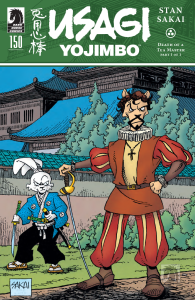 Usagi Yojimbo by Stan Sakai (Dark Horse, 2016)
Usagi Yojimbo by Stan Sakai (Dark Horse, 2016)
Usagi Yojimbo, I will never quit you.
Usagi outlasted the black-and-white fighting animal comic craze of the ‘80s, running for over 200 issues and over 30 years. The historically accurate samurai rabbit outlasted ninja turtles, barbarian aardvarks, kung fu kangaroos, and black belt hamsters. After an extended break, Sakai is back, and the recent stretch of Usagi Yojimbo carries a kind of hardscrabble sadness that was absent the previous volumes.
His ink lines are scratchier now, and his protagonist seems weary and pragmatic. The book’s exploration of feudal Japanese culture, previous celebratory and meditative, have started to show cracks in the seams—Europeans are arriving in Usagi’s Japan, and their disdain for samurai culture feels ominous and fatal.
So the question is, will the dissolution of samurai culture mean the dissolution of Usagi as a character? The next few years of the comic could well be the most interesting chunk of this samurai epic, with Sakai at the top of his cartooning game, and his characters mired in world-changing historical events.
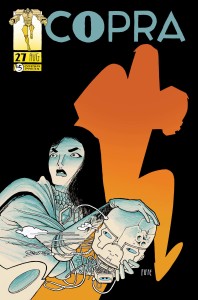 Copra by Michel Fiffe (self-published, 2016)
Copra by Michel Fiffe (self-published, 2016)
Copra is movement. Copra is impressionistic. Copra is a sherbet smear dragged by a sci-fi asteroid after a celestial collision with a planet made of compacted 1980s action movie VHS tapes. Copra is superhero espionage vaulted into cosmic conflict.
One of the most engaging things about shared universes, whether it’s Star Wars, Buffy, or Marvel’s superhero universe, is how details slowly accrete. Writer A creates Character A, Writer B creates Setting B, and then Writer C gracefully combines them in a way that elevates both in a kind of existential cool alchemy.
But in a vast, ever-changing setting like Star Wars or Marvel, those combined details end up being stupid as often as they’re cool. The beauty of Copra comes from the singular mind behind the book: Michel Fiffe.
He’s woven the best superhero tropes, archetypes, and storytelling techniques into one of the most kinetic and visceral comics coming out today. Copra is a team of ne’er-do-wells along the lines of the Suicide Squad blackmailed into working with a master magician a la Dr. Strange, and they’re being drawn into an interdimensional conflict combining the bombast of Jack Kirby and the twisted vectors of Steve Ditko.
But Copra is more than homage. It has an intensely personal feeling—it’s a world of people who’ve been beaten, who’ve made bad choices, and who are constantly walking the line between giving in and rising above. Fiffe talks a lot about how Copra is an exercise of discipline for him—don’t stop moving, keep making pages, and never look back. And the characters of Copra feel the same; they’re sharks, and if they stop moving, they’re dead in the water. So they’re always taking one more mission.
Readers: what do you look for in serial fiction? Cliffhangers? Community? Something else?
The bad news is I’m sitting in an empty room while all my books (and most of the rest of my stuff) is in an entirely different house. This is because moving is hard and I’m bad at planning.
Thankfully, I have a lot of crowdfunded comics to look forward to once I get my change of address form all filled out. Here are two upcoming releases that I’m eager to have dropped in my brand new mailbox.
Sure, the Kickstarter is over, but that just means you can buy all these books directly from 2dcloud.com. This “season” of books fits perfectly together, though, so you should definitely read them all. Here’s the excellent lineup:
- Turning Japanese by MariNaomi
- Someone Please have Sex With Me by Gina Wynbrandt
- Virus Tropical by Powerpaola
- Trying Not to Notice by Will Dinski
I’ve had the pleasure of seeing both MariNaomi and Gina Wynbrandt read excerpts from these releases. Both are brutally honest about their lives and their desires, but that honesty is coupled with so much kindness and humor and empathy that they’ll flat out break your heart. Also, Mari’s lettering is the most immaculate in the business, and Gina’s neon colors make her comics feel like Lisa Frank’s bad trips.
Of all the books, Virus Tropical is the one I know the least about. The description is great, though:
Powerpaola uses a series of vignettes to transform the simplicity of middle-class family life into a thought-provoking narrative that would have been inconceivable prior to Colombia’s sexual revolution. Focusing on the lives of a family of women in the 80’s-90’s, Powerpaola’s tale highlights the excitement, danger, and struggles of a country in the midst of radical change.
And Powerpaola’s mark-making feels passionately obsessive. Just take a look at these preview pages:
And Will Dinski is just a gentleman of indie comics. His older work comprises a body of flawless minicomics, each one an attentively designed art object. For instance: a comic about maps that unfolds like an atlas; a comic about taking a Scientology test that is built around a scan of the test results; and some careful screenprinted covers with glow-in-the-dark ink. But I’ve heard that Trying Not to Notice features a much looser, less controlled Will Dinski, which is an exciting style to look forward to.
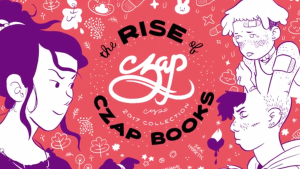 The Rise of Czap Books—The 2017 Collection
The Rise of Czap Books—The 2017 Collection
This one’s still going! Give Czap Books your money right here. The lineup:
- Witchlight by Jessi Zabarsky
- don’t tell me not to worry (i’ll worry all i want) by Kelly Kwang
- Egg Creme #1 by Liz Suburbia
Aw, dang, if only I had my comic collection and my personal computer. Then I could show you some excellent screen caps from Zabarsky’s digitally released Witchlight serial. Even then, it wouldn’t matter since Zabarsky’s remastering them for the book release. Hop over to the Kickstarter to see her exceptional choreography and intricate mapping. It’s about a witch and her kidnapped sidekick—a perfect fantasy setup.
Similarly, if I had my full computer setup, I’d show you Kelly Kwang’s quiet, grainy renditions from Frontier #12, a short comic all about the cosmic loneliness of the Space Youth Cadets. Here’s the only image I have access to:
See that quiet concern? That loving reproduction of digital aesthetics? That airbrush feel of love lived and lost? That’s what you can look forward to in don’t tell me not to worry.
And as for Liz Suburbia’s work, well, it has a feel of primal punk cartooning. Egg Creme is a sequel to the hit Sacred Heart, and the ink on the preview pages looks like it was applied with an angry razor despite its clear storytelling.
So there you go! It’s one million degrees here in Minnesota, and I’m stuck on the second story of a dirty, croaking house with none of my books. And you, dear readers? In these dog days of summer, what kind of literary comfort are you looking forward to?
